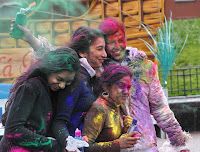 |
| Photo by FaceMePLS |
In Japan, Vernal Equinox Day is even a national holiday, though
this year, it takes on a tragic significance, considering it’s the day the
Japanese visit family graves and hold family reunions.
This time of year also holds religious significance for various
faiths. The Jewish Passover falls on the first full moon day after the vernal
equinox, as does the Christian observance of Easter.
Starting last Sunday, a cluster of festivities take place
per the Hindu calendar, starting with Holi, the Hindu New Year, also known as the Festival of Colors. Depending on region,
that event can last anywhere from a few days to a couple of weeks. It begins on
the first full moon day at the end of the winter season and culminates on the
last full moon day. In the days preceding the festival, followers are supposed
to clean their houses, and on the night before the celebration day, some
communities light a bonfire and gather around it to sing
and dance. But the main event takes place on the vernal equinox, with a playful
festival in which people throw colored powder and water on each other to celebrate.
They also throw water-filled balloons. In some parts of India, people mix bhang (marijuana) in their drink and
food. (Talk about spirited.)
 |
| Source: Victoria Albert Museum |
According to Hindu folklore, the festival has its roots
in an old mythological story, but Lord Krishna is believed to have popularized
the event in later times. (Above is a painting, circa 1788, of Radha, Krishna's beloved, celebrating Holi with the women in their village.)
The southern part of India, known as the Deccan region, celebrates
Holi along with the rest of the country, but also observes another new year
soon after it. Ugadi or Yugadi marks an epoch or an era and right now, we’re in
the Kali Yuga (epoch), which marks the date when Lord Krishna left the world
(midnight between February 17 and 18, in the year 3102 B.C.). That event is now observed on the first new
moon day of the Spring Equinox.
This year, Ugadi falls on April 4, which happens to mark the
beginning of yet another important Hindu festival, Navratri, which literally
means nine nights. Navratri occurs four times a year, one for each season, but the
most popular one occurs in the fall. All four are celebrated by
worshipping devi, the divine goddess,
in all her diverse forms and often with nine days of fasting, culminating in a prayer ceremony
and a day of indulging in rich sweets and savories. Many Indian women consider Navratri
their most important festival, because it’s the one that celebrates the many aspects
of feminine divinity (among them, strength, fertility, wisdom, courage, and
comfort). Young girls are often invited to be part of the prayer rituals, as
they represent purity. And in a tribute to the changing season, some Hindus begin the observances by sprouting seeds.
Here's a short video, a three-minute ad, about how it feels to experience Holi, also known as
the festival of color. (Not to give anything away, but it’s worth watching for
the surprise ending).
We have a Hari Krishna temple about half an hour away and they do a big Holi festival every year. I think they're holding it this Saturday. It looks fun! My sisters have ruined plenty of my towels participating. :)
ReplyDeleteSo nice to see you here, Jordan! It's a new year---might be time for new towels too. ;) Have fun and let us know how it goes!
ReplyDeleteI'm ready to adopt Navratri as my personal favorite holiday! Maybe I'll set out some seeds to sprout, too. Any particular kind?
ReplyDeleteI'm no expert, Heidi, but I think barley is the seed of preference. However, anything that sprouts would do the trick. Whole green gram (lentil) and chickpeas work too. The general idea is to herald a fresh start full of abundance.
ReplyDeleteWhat a fabulous post, Surpriya. The video made me cry, btw. I'm such a softy.
ReplyDelete